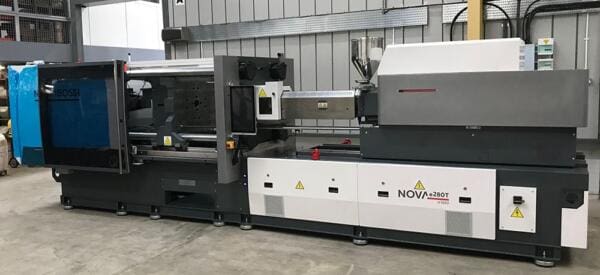
NOVA eT Technology Improves Process and Productivity for IVM
Less than six months after the delivery of their first NOVA eT All-Electric machine, County Durham based IVM Ltd has taken delivery of a 280-tonne model. The machine was purchased to produce an existing under-seat automotive component, with a visible and textured front face.
The tool previously ran on a modern 270-tonne hydraulic machine achieving a 46 second cycle time. There were serious quality issues relating to gas being trapped within the tools cavity. Despite the addition of ‘vents’, surface defects resulting from burning were at an unacceptable level. IVM’s Managing Director, Ian Davidson commented,
“People are surprised when we tell them that we chose All-Electric technology primarily to increase productivity and improve the quality of an existing component. We all know that these machines use less energy, are cleaner, quieter and have a much smaller cooling requirement than hydraulic models. These are all contributing factors, but we wouldn’t have made this decision based on these benefits alone.
“We were confident that the proven advantages of the NOVA eT could help us to resolve both the current quality concern, and reduce the cycle time. Having now eliminated the gas burning issue and also significantly reduced cycle times, we were right to be optimistic.”
“Venting is no longer an issue, as we are able to commence material injection when the tool faces are exactly 0.5mm apart. This ability to utilise ‘pre-injection’ has both resolved the quality issue and contributed towards the cycle time improvement.
“Most of the cycle time reduction directly relates to the machine’s technological advantages. For example, the opening stroke has been reduced by a second, the machine ‘relaxing’ the toggles towards the end of the cooling phase. This means that acceleration is virtually instantaneous once mould opening commences.
“Component ejection now commences once mould open is at 60mm. This ability to ‘eject on the fly’ also means that there is no dwell between mould fully open and mould close commencing.”
“In summary, the NOVA eT is a ‘fast’ machine when you compare it to a servo-hydraulic equivalent. All movements have a higher acceleration and deceleration curve, which when coupled with the ability to overlap all phases of the mould cycle, equates to greater productivity.
“All-Electric technology comes with a price premium, only some of which can be justified by energy savings. Shaving 20% off a cycle time is the real benefit to us, as higher productivity means lower part cost and a quicker ROI.”
Negri Bossi Group CEO, Craig Ward, recently attended an Open Day at the UK’s Rugby facility. His presentation made a very compelling argument for investment in all-electric technology when machines are below 250 tonnes, citing ‘life costs’ and productivity levels as paramount to European manufacturing facilities and their related overheads.
He went on to postulate that most costings/justifications for the higher levels of investment required were not sophisticated enough and therefore accurate enough to give the correct outcome when deciding between hydraulic or all-electric technology. When done correctly, the conclusion should invariably be, that in the European market, there was no longer a place for a high-end, sub-250-tonne hydraulic machine. Investing in machines such as the NOVA eT should future proof the purchasing decision, as the argument will only become more compelling during the service life of the equipment.
The NOVA eT range is available in tonnages between 50 and 350 tonnes and with a choice of injection units. A 130-tonne machine is currently available to view at Negri Bossi UK’s Rugby showroom.
Negri Bossi
+44 (0) 1788 222550
Website
Email





